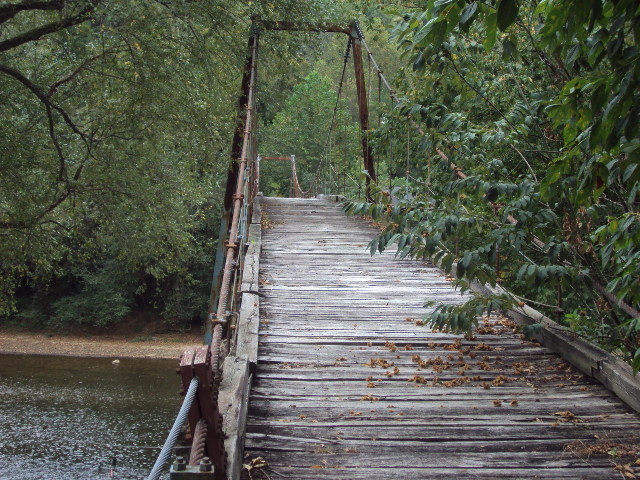We Recommend:
Bach Steel - Experts at historic truss bridge restoration.
BridgeHunter.com Phase 1 is released to the public! - Visit Now
Elkhurst Swinging Bridge

Primary Photographer(s): Tammy Marie Rose
Bridge Documented: July 1, 2010
Elkhurst: Clay County, West Virginia: United States
Not Available or Not Applicable
192.0 Feet (58.5 Meters)
424.0 Feet (129.2 Meters)
8.2 Feet (2.5 Meters)
3 Main Span(s)
08A055

View Information About HSR Ratings
Bridge Documentation
This bridge's future is at risk!
Bridge Status: This historic bridge is slated for demolition!View Archived National Bridge Inventory Report - Has Additional Details and Evaluation
This bridge is an extremely rare and significant bridge for West Virginia for which preservation should be given high priority. It is the only surviving example listed in the National Bridge Inventory of a suspension bridge that is located entirely within West Virginia. (not a border bridge). It is also listed as the only vehicular "swinging" type suspension bridge in the state. "Swinging" suspension bridges refer to a generalized class of suspension bridges that are normally among the smallest suspension bridges constructed and generally have very little or no stiffening trusses/girders. They tend to be of simple, relatively unsophisticated construction, often with a wooden deck, lightweight cables, and narrow deck width. All of these features combine to form a bridge that tends to noticeably flex under weight and wind, giving rise to the name "swinging bridge." While the main span of 129 feet is of fair size for a bridge for this bridge, with a three span suspension design, where there are suspender cables supporting a deck on both sides of the two towers, rather than just in between towers, the bridge obtains an impressive overall length of 424 feet, placing it among the longest known surviving examples in the nation of swinging suspension bridges such as the 500 foot Grand Auglaize Suspension Bridge in Missouri and the 403 foot Regency Suspension Bridge in Texas. This suggests that the bridge is noteworthy on a national scale as well.
Given that this bridge is the only example of its type in West Virginia as described above, and is also among the longest known examples of a genuine swinging style suspension bridge in the country, this bridge should be given a high priority for preservation. There are a variety of options that could be considered for the preservation of this bridge, enough that demolition should not even be considered. The bridge could be rehabilitated for continued one-lane light vehicular use. The bridge has an exceptionally low amount of average daily traffic, only 50, and so a two lane bridge should not be needed here. The rehabilitation of the bridge for vehicular use should respect the historic integrity of the bridge by minimizing alteration. However, bridges such as this can be retrofitted with new and additional cables for increased strength, while still retaining the original cables to maintain historic integrity. This was done with the Mill Creek Suspension Bridge in Missouri, although the majority of that particular bridge was badly altered. If rehabilitation for vehicular use is rejected as an acceptable solution, the historic bridge could instead be preserved for pedestrian use, either with or without a new replacement vehicular bridge on a new alignment. The Beveridge Bridge in San Saba County, Texas is a excellent example of a swinging style suspension bridge that was rehabilitated and preserved for pedestrian use. With the Beveridge Bridge, a new bridge was built nearby to serve the needs of vehicular traffic.
Unfortunately, at this time demolition is planned for this important historic bridge, despite preservation support from both the local community and elsewhere. They have set up an online petition to express support for the preservation of this historic bridge, and you are encouraged to sign it as well.
![]()
Photo Galleries and Videos: Elkhurst Swinging Bridge
Bridge Photo-Documentation
Mobile Optimized PhotosA collection of overview and detail photos. This gallery features data-friendly, fast-loading photos in a touch-friendly popup viewer.
Alternatively, Browse Without Using Viewer
![]()
Maps and Links: Elkhurst Swinging Bridge
Coordinates (Latitude, Longitude):
Search For Additional Bridge Listings:
Bridgehunter.com: View listed bridges within 0.5 miles (0.8 kilometers) of this bridge.
Bridgehunter.com: View listed bridges within 10 miles (16 kilometers) of this bridge.
Additional Maps:
Google Streetview (If Available)
GeoHack (Additional Links and Coordinates)
Apple Maps (Via DuckDuckGo Search)
Apple Maps (Apple devices only)
Android: Open Location In Your Map or GPS App
Flickr Gallery (Find Nearby Photos)
Wikimedia Commons (Find Nearby Photos)
Directions Via Sygic For Android
Directions Via Sygic For iOS and Android Dolphin Browser
USGS National Map (United States Only)
Historical USGS Topo Maps (United States Only)
Historic Aerials (United States Only)
CalTopo Maps (United States Only)

